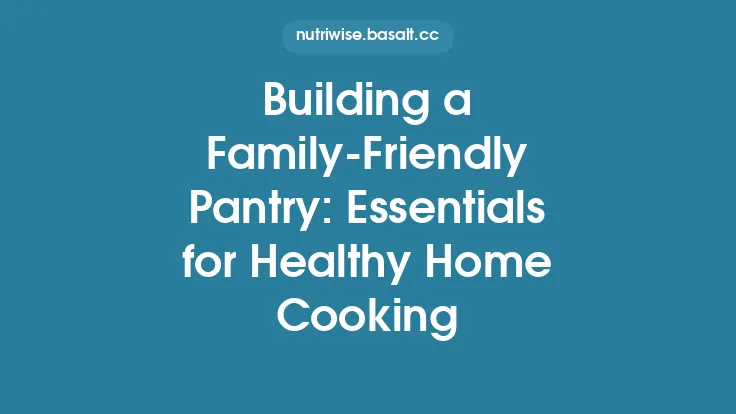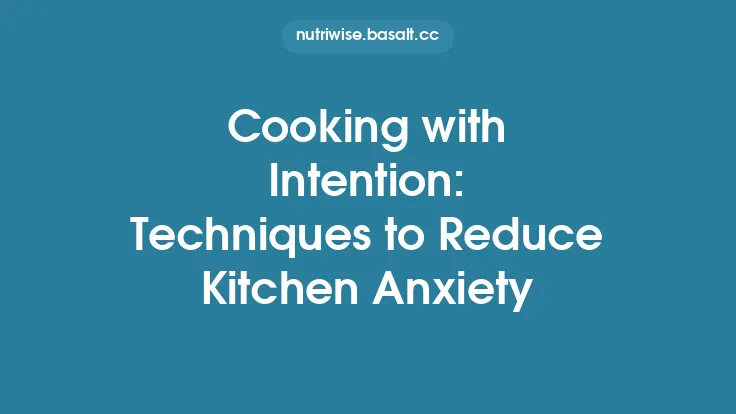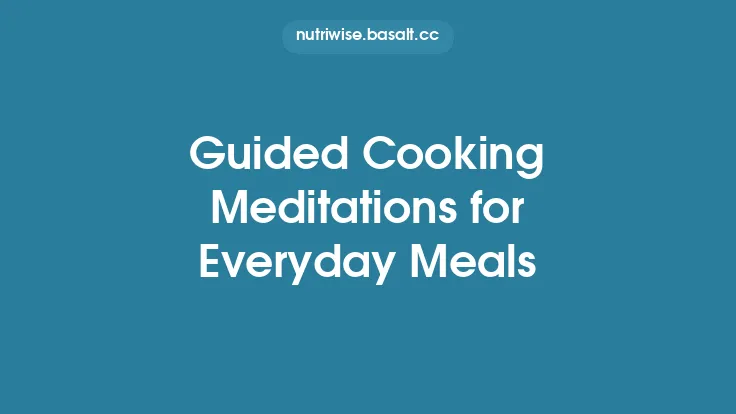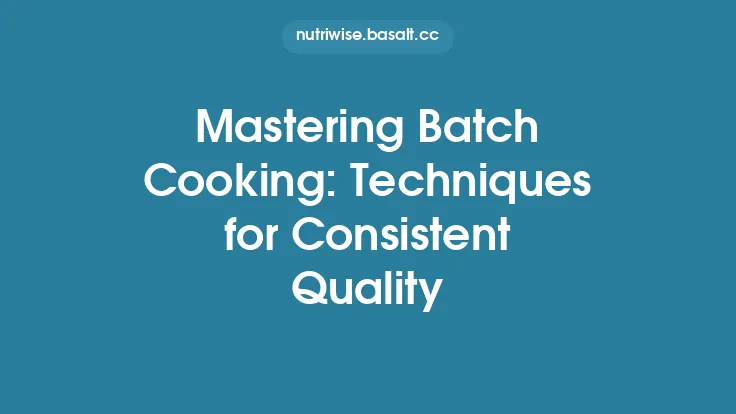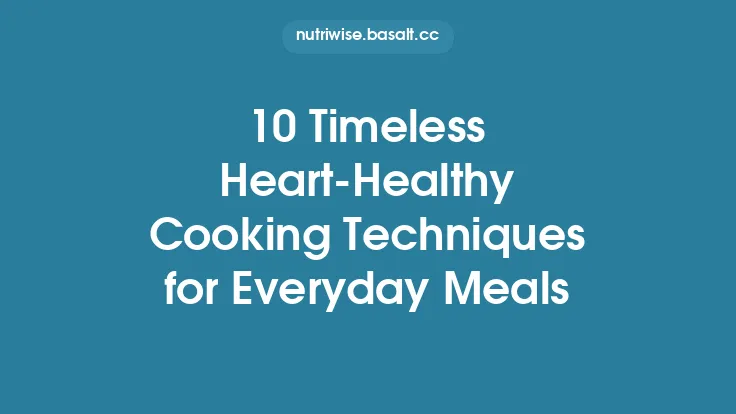Cooking is often seen as a series of tasks that demand precision, timing, and a steady hand. Yet, the kitchen can also become a hotbed of stress—sharp knives, sizzling pans, and the ticking clock of a dinner deadline can quickly turn a creative space into a pressure cooker. One of the most accessible, cost‑free tools for reclaiming calm in this environment is the breath. By learning how to harness specific breathing patterns, you can lower physiological arousal, sharpen focus, and create a more relaxed cooking experience without sacrificing efficiency or flavor.
Understanding the Physiology of Breath in the Kitchen
When you encounter a stressful stimulus—such as a sudden flare of flame or a looming deadline—your sympathetic nervous system (SNS) fires up. This “fight‑or‑flight” response releases catecholamines (adrenaline and noradrenaline), raising heart rate, constricting blood vessels, and prompting shallow, chest‑dominant breathing. The resulting hyperventilation reduces carbon dioxide (CO₂) levels in the blood, leading to light‑headedness, tremor, and impaired fine motor control—none of ideal conditions for delicate knife work or precise timing.
Conversely, activating the parasympathetic nervous system (PNS) through slow, diaphragmatic breathing triggers the vagus nerve, which:
- Lowers heart rate and blood pressure
- Increases heart‑rate variability (HRV), a marker of stress resilience
- Enhances oxygen delivery to the brain and muscles
- Promotes a state of calm alertness, often described as “flow”
By deliberately shifting the breath from shallow thoracic patterns to deeper abdominal cycles, you can modulate the balance between SNS and PNS, creating a physiological environment that supports both relaxation and focused attention.
Core Breathing Techniques for Culinary Calm
| Technique | Pattern | Duration | Primary Benefits | Ideal Kitchen Moment |
|---|---|---|---|---|
| Diaphragmatic (Abdominal) Breathing | Inhale through nose, expanding belly; exhale through mouth, gently contracting belly | 4‑6 seconds inhale, 6‑8 seconds exhale | Reduces cortisol, improves oxygenation | General prep, simmering, waiting periods |
| Box (Square) Breathing | Inhale‑hold‑exhale‑hold, each equal | 4‑5 seconds each phase | Stabilizes heart rate, enhances concentration | High‑heat searing, timing critical steps |
| 4‑7‑8 Breath | Inhale 4 s, hold 7 s, exhale 8 s | Fixed 19‑second cycle | Deep relaxation, quick transition to PNS | Post‑cooking cleanup, before tasting |
| Alternate Nostril (Nadi Shodhana) | Close right nostril, inhale left; close left, exhale right; repeat opposite | 5‑10 cycles | Balances hemispheric activity, reduces anxiety | When multitasking (e.g., chopping while sauce simmers) |
| Pursed‑Lips Exhalation | Inhale normally; exhale through pursed lips, lengthening outflow | 6‑8 seconds exhale | Lowers respiratory rate, steadies breath under heat | Near open flame or grill, where heat spikes stress |
Each technique can be practiced in a matter of seconds, making them practical for the fast‑paced kitchen environment.
Integrating Breathwork into Different Cooking Stages
1. Ingredient Preparation (Mise en Place)
The prep stage often involves repetitive motions—chopping, peeling, measuring—that can become mind‑less. Use this time to establish a baseline breathing rhythm. Begin with diaphragmatic breathing: place one hand on the abdomen, inhale through the nose, feel the belly rise, and exhale through the mouth, feeling it fall. Even a few conscious cycles can lower baseline heart rate before the heat of cooking begins.
2. Cooking Under Heat
When a pan reaches smoking point or a sauce begins to boil aggressively, the body’s stress response spikes. Deploy box breathing: inhale for a count of four while the pan heats, hold for four as you add ingredients, exhale for four while stirring, and hold again for four before the next step. This rhythmic pattern synchronizes with the natural cadence of stirring or flipping, turning breath into a metronome that steadies both mind and hand.
3. Timing Critical Steps
Many recipes hinge on precise timing—e.g., “simmer for 2 minutes, then add the finishing herb.” Use the 4‑7‑8 breath to create a short, calming pause before the critical moment. Inhale for four seconds, hold for seven, then exhale slowly for eight. This brief reset reduces the likelihood of rushed, error‑prone actions.
4. Plating and Presentation
The final stage often carries the pressure of visual perfection. Alternate nostril breathing can help maintain composure while arranging components. By balancing the flow of air through each nostril, you subtly balance the activity of the left and right brain hemispheres, supporting both artistic creativity and analytical precision.
5. Cleanup
Post‑cooking cleanup can feel like an afterthought, yet it’s an opportunity to cement the calm you cultivated. The pursed‑lips exhalation is especially useful when dealing with hot pots or steam, as it naturally slows the breath and reduces the urge to rush.
Breathing for Safety and Precision
A calm breath does more than reduce stress; it directly influences motor control. Research in occupational ergonomics shows that diaphragmatic breathing improves fine‑motor steadiness by:
- Reducing tremor amplitude in the fingers
- Enhancing proprioceptive feedback (the sense of limb position)
- Lowering the incidence of accidental cuts and burns
When handling a sharp knife, pause for a single diaphragmatic breath before each cut. This micro‑pause creates a momentary “reset” that aligns visual focus with hand movement, decreasing the risk of slips.
Similarly, when working near open flames or hot oil, a controlled exhalation through pursed lips can prevent the involuntary gasp reflex that sometimes leads to inhaling hot vapors. By consciously regulating the exhalation, you keep the airway protected while maintaining a steady flow of oxygen.
Customizing Breath Practices for Your Kitchen Environment
Space Constraints
In a cramped kitchen, you may not have room for full‑body posture changes. Focus on breath depth rather than posture: sit upright on a stool, place a hand on the abdomen, and practice diaphragmatic breathing while standing at the counter. The key is to keep the diaphragm engaged, not the shoulders.
Noise Levels
Background noise—blenders, exhaust fans, conversation—can distract from breath awareness. Use a subtle auditory cue, such as the sound of a simmering pot, to anchor your inhale. Count silently to the rhythm of the bubbling, aligning breath cycles with the auditory pattern.
Temperature Extremes
When the kitchen is hot, the body naturally increases breathing rate to dissipate heat. Counteract this by lengthening the exhalation phase, which helps maintain CO₂ balance and prevents hyperventilation. The pursed‑lips technique is especially effective in hot environments.
Cooking with Others
If you’re cooking with family or colleagues, synchronize breathing moments. For example, before a group begins a shared task (e.g., tossing a large salad), take a collective three‑second inhale and exhale. This creates a shared physiological reset, fostering a calmer collaborative atmosphere.
Measuring the Impact: How to Track Your Progress
- Heart‑Rate Variability (HRV) Apps – Many wearable devices provide HRV scores, a direct indicator of PNS activation. Record baseline HRV before cooking sessions and compare after implementing breathwork. A consistent rise suggests improved stress resilience.
- Subjective Stress Scales – Use a simple 1‑10 rating before and after cooking. Over weeks, look for a downward trend in perceived stress.
- Error Log – Keep a brief notebook of kitchen mishaps (e.g., cuts, burnt dishes). Note whether you employed a breathing technique at the time. A reduction in incidents correlates with effective breath integration.
- Cooking Time Consistency – Track the variance in timing for steps that require precision (e.g., “simmer 5 minutes”). Less variance often reflects steadier focus.
By quantifying these metrics, you can objectively assess how breathwork is enhancing both your culinary performance and well‑being.
Common Pitfalls and How to Avoid Them
| Pitfall | Why It Happens | Solution |
|---|---|---|
| Shallow, rapid breathing under heat | SNS dominance, instinct to “cool down” quickly | Consciously switch to diaphragmatic breathing; place a hand on the belly to feel expansion |
| Skipping breath pauses during multitasking | Perceived loss of efficiency | Integrate micro‑pauses (1‑2 breaths) between tasks; they actually improve speed by reducing errors |
| Over‑thinking the technique | Anxiety about “doing it right” | Remember that any intentional breath is beneficial; perfection is not required |
| Holding breath while stirring | Habitual tension | Pair each stir with an exhale; the motion becomes a cue for breath release |
| Neglecting exhalation length | Focus on inhale only | Use a timer or count silently to ensure exhale is longer than inhale (e.g., 4‑6 s inhale, 6‑8 s exhale) |
Beyond the Stove: Extending Breath Awareness to Kitchen Life
The benefits of mindful breathing do not end when the last plate is cleared. Incorporating breath awareness into broader kitchen habits can reinforce the calm you cultivated while cooking:
- Ingredient Shopping – Take three diaphragmatic breaths before entering the grocery aisle to set a relaxed tone for selection and budgeting.
- Meal Planning – Use box breathing while reviewing recipes, allowing space for thoughtful decision‑making rather than rushed choices.
- Kitchen Clean‑up Routines – End each cleaning session with a 4‑7‑8 breath, signaling a transition from work to rest.
By treating the kitchen as a holistic environment rather than a series of isolated tasks, you embed breathwork into the rhythm of daily life, fostering long‑term stress resilience and a more enjoyable relationship with food preparation.
Incorporating intentional breathing into your cooking routine is a simple yet powerful strategy to transform the kitchen from a source of tension into a sanctuary of calm focus. By understanding the physiological underpinnings, mastering a handful of versatile breath techniques, and weaving them seamlessly into each stage of the culinary process, you not only enhance your own well‑being but also elevate the quality and safety of the meals you create. The next time you step into the kitchen, let your breath be the first ingredient you season—steady, purposeful, and effortlessly present.

